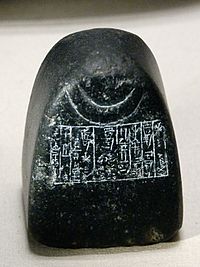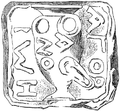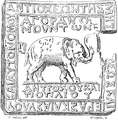Mina (unit)

Themina/ˈmaɪnə/(Akkadian:𒈠𒈾,romanized:manû;Ugaritic:𐎎𐎐,romanized:mn;Imperial Aramaic:מְנֵא,romanized:mənēʾ;Hebrew:מָנֶה,romanized:māneh;[a]Classical Syriac:ܡܢܝܐ,romanized:manyāʾ;Ancient Greek:μνᾶ,romanized:mnā;Latin:mina) is an ancientNear Easternunit of weight for silver or gold, equivalent to approximately 1.25 pounds (0.57 kg), which was divided into 60shekels.The mina, like the shekel, eventually also became a unit ofcurrency.
History[edit]
Sumerian[edit]
From earliestSumeriantimes, a mina was a unit of weight. At first, talents and shekels had not yet been introduced. By the time ofUr-Nammu(shortly before 2000 BCE), the mina had a value of1⁄60talentas well as 60shekels.The weight of this mina is calculated at 1.25 pounds (0.57 kg), or 570 grams of silver (18 troy ounces).[1][2]
Semitic languages[edit]

The word mina comes from the ancientSemitic rootm-n-w/m-n-y'to count',[3]Akkadianmanû,[4]Hebrew:מָנָה(mana),Imperial Aramaic:מָנָה/מְנָא(mana/mena),[5]Classical Syriac:ܡܢܳܐ(mena),[6]Ugaritic:𐎎𐎐,romanized:mn.It is mentioned in the Bible, where Solomon is reported to have made 300 shields, each with 3 "mina" of gold (Hebrew:מָנֶה,romanized:mane),[7]or later after the Edict ofCyrus II of Persiathe people are reported to have donated 5000 minas of silver for the reconstruction ofSolomon's TempleinJerusalem.[8]
In theCode of Hammurabiwhich is considered one of the first examples of written law, the mina is one of the most used terms denoting the weight of gold to be paid for crimes or to resolve civil conflicts.[9]
In the Biblical story ofBelshazzar's feast,the wordsmene, mene, tekel, upharsinappear on the wall (Daniel 5:25), which according to one interpretation can mean "mina, mina, shekel, and half-pieces", although Daniel interprets the words differently for King Belshazzar.
Writings fromUgaritgive the value of a mina as equivalent to fifty shekels.[10]The prophetEzekielrefers to a mina (manehin theKing James Version) also as 60 shekels, in theBook of Ezekiel45:12.Jesus of Nazarethtells the "parable of the minas"inLuke19:11–27, also told as the "parable of the talents" inMatthew25:14–30. In later Jewish usage, themanehis equal in weight to 100denarii.[11]
From theAkkadianperiod, 2 mina was equal to 1silaof water (cf.clepsydra,water clock).
Greek[edit]
Inancient Greece,the mina was known as theμνᾶ(mnâ). It originally equalled 70drachmaebut later, at the time of the statesmanSolon(c. 594 BC), was increased to 100 drachmae.[12]The Greek wordmna(μνᾶ) was borrowed from Semitic.[13][14]Different city states used minae of different weights. The Aeginetan mina weighed 623.7 g (22.00 oz).[15]The Attic mina weighed 436.6 g (15.40 oz).[16]In Solon's day, according toPlutarch,the price of a sheep was one drachma or amedimnos(about 40 kg) of wheat.[17]Thus a mina was worth 100 sheep.
Latin[edit]
The wordminaalso occurs in Latin literature, but mainly in plays ofPlautusandTerenceadapted from Greek originals. In Terence's playHeauton Timorumenos,adapted from a play of the same name by the Greek playwrightMenander,a certain sum of money is referred to in one place as "ten minae" (line 724) and in another as "1000 drachmas of silver" (line 601).[18]Usually the wordminareferred to a mina of silver, but Plautus also twice mentions a mina of gold.[19]In the 4th century BC, gold was worth about 10 times the same weight of silver.[20]In Plautus, 20 minae is mentioned as the price of buying a slave.[21]It was also the price of hiring a courtesan for a year.[22]40 minae is given as the price of a house.[23]
In classical Latin the approximate equivalent of a mina was thelibra(the word also meant "balance" or "weighing scales" ).[24]With a weight of only 328.9 g (11.60 oz), however, the Romanlibrawas lighter than either a Greek mina or a modern pound of 16 ounces. It was divided into 12 Roman ounces. Sometimes the wordlibrawas used together with the wordpondo"in weight", e.g.libram pondo"a pound in weight" (Livy, 3.29); but oftenpondowas used alone; e.g.auri quinque pondo"five (pounds) in weight of gold" (Cicero,pro Cluentio179). Hence the wordpondoby itself came to mean "pound(s)".[25]From Latinpondocomes the English word "pound", and fromlibracome the abbreviations "lb" (for weight) and thepound sign"£" (for money).
Images[edit]
-
Mina ofAthens.
-
Mina ofChios.
-
Mina ofAntiochus IV Epiphanes.
-
Mina ofAntioch.
Notes[edit]
References[edit]
- ^Edwards, Tom."Bible Weights, Measures, and Monetary Values".SpiritRestoration.org.Archived fromthe originalon 21 January 2012.Retrieved28 November2008..Calculation of weight by number of shekels.
- ^
 Singer, Isidore;et al., eds. (1901–1906)."Money".The Jewish Encyclopedia.New York: Funk & Wagnalls.
Singer, Isidore;et al., eds. (1901–1906)."Money".The Jewish Encyclopedia.New York: Funk & Wagnalls.
- ^"mina",The American Heritage Dictionary of the English Language
- ^"manû",Akkadian Dictionary,Association Assyrophile de France
- ^Jastrow, Marcus (1903),Dictionary of the Targumim, Talmud Bavli, Talmud Yerushalmi and Midrashic Literatureמְנֵי[Mənei], London, W.C.: Luzac & Co.; New York: G. P. Putnam's Sons
- ^"Search Entry"ܡܢܵܐ['mna],Sureth dictionary,Association Assyrophile de France
- ^1 Kings 10:17.
- ^Ezra 2:69Archived2018-10-04 at theWayback Machine.
- ^[1]Sacred Texts
- ^Tenney, Merril ed.,The Zondervan Pictorial Encyclopedia of the Bible,vol. 5, "Weights and Measures," Grand Rapids, MI: Zondervan, 1976.
- ^Maimonides(1974).SeferMishneh Torah- HaYad Ha-Chazakah (Maimonides' Code of Jewish Law)(in Hebrew). Vol. 4 (Seder Avodah). Jerusalem: Pe'er HaTorah.,s.v. Hil.Kelei HaMikdash2:3
- ^Aristotle(unknown date).Constitution of the Athenians,10.2.
- ^Jastrow, Marcus (1903).Dictionary of the Targumim, Talmud Bavli, Talmud Yerushalmi and Midrashic Literature.London, W.C.: Luzac & Co.; New York: G. P. Putnam's Sons.
- ^Henry George Liddell; Robert Scott (1940).A Greek–English Lexicon.Oxford: Clarendon Press.
- ^Oleson (1998),p. 764
- ^Oleson (1998),p. 764
- ^Plutarch,Solon23.
- ^A. J. Brothers (1988),Terence: The Self-Tormentor,note on line 601.
- ^Plautus,Miles Gloriosus1420,Truculentus893.
- ^Hammond, Mason et al. (1963)Plautus: Miles Gloriosuson line 1061.
- ^Plautus,Pseudolus53;Captivi380.
- ^Plautus,Asinaria230.
- ^Plautus,Trinummus403.
- ^Lewis and Short,Latin Dictionary,s.v.libra.
- ^Lewis and Short,Latin Dictionary,s.v.pondo.
Bibliography[edit]
- Oleson, John Peter (2008).The Oxford Handbook of Engineering and Technology in the Classical World.Oxford University Press.ISBN9780199734856.




